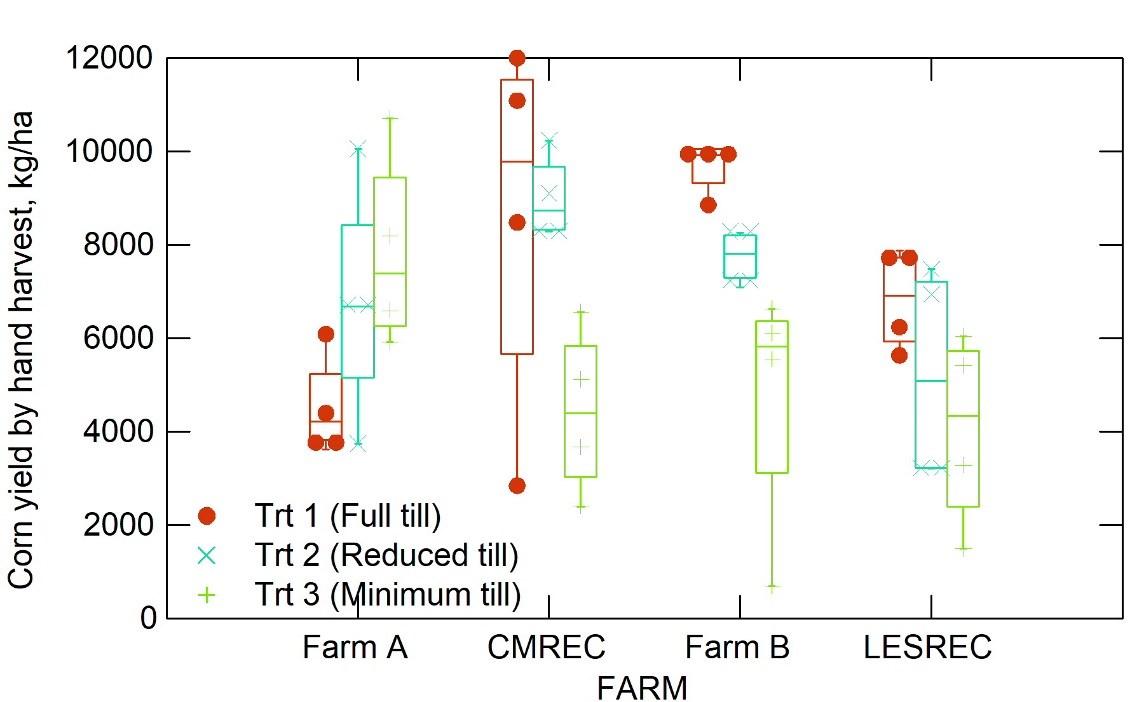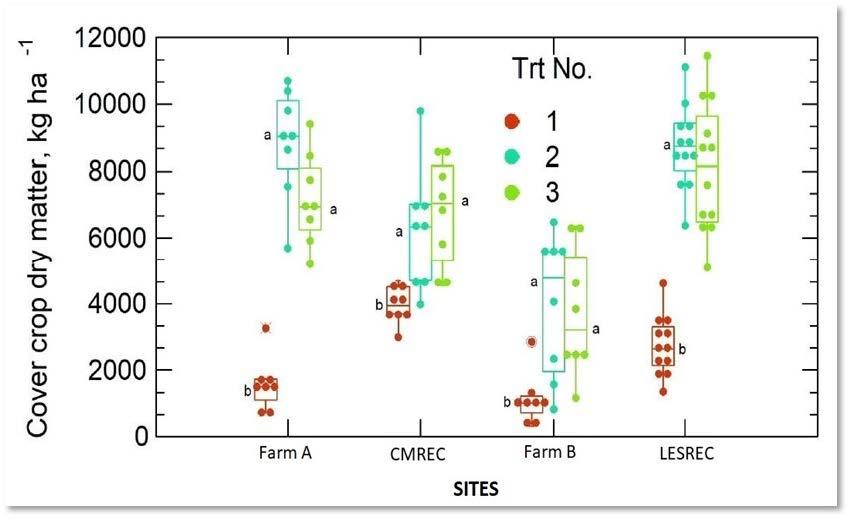Interested in $10 corn and $30 soybeans for certified organic, but not sure how to transition?
Biwek Gairhe¹, Sarah Hirsh², and Ray Weil¹
¹Department of Environmental Science and Technology, University of Maryland College Park
²University of Maryland Extension, Somerset County
New project aims to assess four organic transition strategies for impacts on profits, productivity, soil health, and environment
Why Organic Grain?
Organic grain production is promoted for greater potential profits with premium grain prices, improved soil health with organic inputs and fewer environmental hazards in the absence of synthetic chemical use. However, the three-year period required for organic certification is a challenging phase when transitioning farmers are learning to do without synthetic chemical manage soil fertility, weeds, diseases and pests, while not yet receiving those attractive premium prices (Delate and Cambardella, 2004). Organic grain production, if done regeneratively, may reduce environmental impacts and increase ecosystem services from agriculture. Among the latter, minimization of nutrient loss to water is especially important in Maryland, since a good deal of the nitrogen and phosphorus pollution to the Chesapeake Bay comes from agriculture (2025 Watershed Implementation Plans (WIPs)). However, the change in environmental impacts due to the transition from “conventional” to organic farming could be either positive or negative (Bavec and Bavec, 2015), depending on the system of practices (inputs, soil disturbance, soil cover, etc.) utilized in the conventional and organic systems (Röös et al., 2018).
Organic farmers typically use animal manures as well as legume cover crops to maintain soil fertility and rely on tillage to prepare seedbeds, incorporate amendments, and control weeds (USDA, 2020). In contrast to “conventional” grain farms in much of the world, most “conventional” grain farms in Maryland practice some form of no-till agriculture, grow cover crops over the winter (Soil Health Census Report USA, 2019), and use nutrient management plans to avoid excess nutrient loss (MDA, 2009). The controlled nutrient, minimum tillage, cover cropping “eco-friendly” starting point in Maryland begs the question of whether transitioning to organic farming practices from the “conventional” practices would cause an increase or decrease in environmental impacts and soil health. Since Maryland grain farmers predominantly use no-till or minimum-till soil management, a switch to traditional organic farming methods could involve significant increases in soil disturbance, erosion and runoff and possible decreases in soil carbon, earthworms, and mycorrhizal fungi, especially during the transition period.
As crucial as is the maintenance of soil and environmental health and crop productivity in transitioning to organic farming, there are very few studies comparing the relative advantages of different organic transition systems (Tully & McAskill, 2020). Thus, in striving for those high organic grain prices we need find organic transition management strategies that can match or exceed the soil health and environmental benefits of the no-till with cover crops grain production systems that organic grain would be replacing. It is also critical that these strategies provide acceptable economics and practicality for transitioning farmers who, as no-tillers, may own little or no tillage and cultivation equipment. For these reasons we recently established a project funded by USDA/NIFA to study a suite of practices that could make the transition to organic grain farming more regenerative than typically practiced.
Project Objectives and Design
The research goal is to compare four organic transition strategies along a continuum of soil disturbance, soil cover, and input cost. In order from most to least disturbance, the four transition systems are 1) Traditional full-tillage grains with simple cover crops (FT) 2) Reduced-till grains with high biomass cover crops (RT) 3) Minimum-till grains with precision-zoned high biomass diverse cover crops (MT) 4) Perennial alfalfa-grass hay, untilled (NT). The project will assess the impacts of these transition strategies on 1) soil health, 2) farm profitability, and 3) crop productivity 4) nutrient losses.
To test the four strategies, we established field-scale replicated plots in four Maryland locations, including two university experiment station farms (LESREC and CMREC) and two commercial farms (we will refer to them as Farm A and Farm B). The systems are being tested in randomized complete block experiments, with the treatments repeated four times on each farm. The transition phase began in spring 2020 by planting spring oats as a first transition crop and uniformity trial, and the plots are expected to be certified organic beginning spring 2023 when a rotation of organic crops will begin with a corn crop in all treatments to serve as a bioassay of the effectiveness of the preceding transition strategies.
In late summer/fall 2020, after the oat harvest, we collected baseline soil samples to 30cm depth. A suite of detailed data will be collected each year during the three-year transition period and after completion of the transitional phase. Soil samples for soil health assessment will be collected in fall 2022 and 2023 for comparison with the baseline samples form 2020. A final assessment of the transition treatments will be made by planting corn in all plots in the spring 2023.
For assessing the soil health, soil physical (bulk density, porosity, aggregate stability, soil strength, etc.), chemical (total carbon, active carbon, soil test nutrients, Cation Exchange Capacity, pH, etc.), and biological properties (soil respiration, earthworm population, microbial community structure, diversity, and functionality) will be measured. The study of soil biological properties is made possible by a separate USDA/SARE grant which will fund the use of metagenomic techniques. Seasonal trends for the soil temperature, water, and EC are being monitored using buried sensors integrated with dataloggers. Because of the complex variables involved, a soil quality index will be developed to simplify the comparison of changes in soil health. We also plan to evaluate environmental impacts by measuring nutrient in leaching and runoff water using suction lysimeters and runoff weirs during the last two years of the study.
Crop stand establishment, yield and profitability will be assessed. Enterprise budgets will be analyzed for each of the four strategies at all four sites. The farmers will log their time, crop value, and input and fuel expenses. These budgets will track all inputs and outputs during the duration of the study to calculate income, variable costs, and fixed costs for all research plots. These economic data will then be generalized to infer income, expenses, and profit per acre and per production unit (bushel of grain or ton of hay).
We aim to identify system parameters that positively impact soil quality, crop yields, practicality, and profitability. The result will help to develop practices to minimize soil disturbance, environmental impacts, and input costs while providing profits during the transition comparable to those realized under conventional grain farming.
Preliminary Findings
Treatment 3 grew a complex summer cover crop immediately after oat harvest in July 2020 followed by a winter cover crop planted in September. Treatments 1 and 2 also had winter covers planted in September or October 2020. In May 2021, we collected cover crop biomass samples before termination at all four sites. Blue River organic food-grade corn hybrid was planted with a target of 30,000 seeds/acre (74,100 seeds/ha). We also measured weed biomass and corn yield in September-October 2021. For corn yield, samples were collected from one or two (depending on plot size) representative locations per plot. At each sampling location we counted the total number of plants and ears and hand-harvested and weighed the ears from two adjacent 20-ft rows. Subsamples of corn ears were dried in the lab and the dry weight of grains per unit area determined. Cover crop and weed biomass samples were taken from multiple 0.25 square meter quadrants and dried in the lab to obtain the dry biomass per unit area.
 English
English العربية
العربية Български
Български 简体中文
简体中文 繁體中文
繁體中文 Hrvatski
Hrvatski Čeština
Čeština Dansk
Dansk Nederlands
Nederlands Suomi
Suomi Français
Français Deutsch
Deutsch Ελληνικά
Ελληνικά हिन्दी
हिन्दी Italiano
Italiano 日本語
日本語 한국어
한국어 Norsk bokmål
Norsk bokmål Polski
Polski Português
Português Română
Română Русский
Русский Español
Español Svenska
Svenska Català
Català Filipino
Filipino עִבְרִית
עִבְרִית Bahasa Indonesia
Bahasa Indonesia Latviešu valoda
Latviešu valoda Lietuvių kalba
Lietuvių kalba Српски језик
Српски језик Slovenčina
Slovenčina Slovenščina
Slovenščina Українська
Українська Tiếng Việt
Tiếng Việt Shqip
Shqip Eesti
Eesti Galego
Galego Magyar
Magyar Maltese
Maltese ไทย
ไทย Türkçe
Türkçe فارسی
فارسی Afrikaans
Afrikaans Bahasa Melayu
Bahasa Melayu Kiswahili
Kiswahili Gaeilge
Gaeilge Cymraeg
Cymraeg Беларуская мова
Беларуская мова Íslenska
Íslenska Македонски јазик
Македонски јазик יידיש
יידיש Հայերեն
Հայերեն Azərbaycan dili
Azərbaycan dili Euskara
Euskara ქართული
ქართული Kreyol ayisyen
Kreyol ayisyen اردو
اردو বাংলা
বাংলা Bosanski
Bosanski Cebuano
Cebuano Esperanto
Esperanto ગુજરાતી
ગુજરાતી Harshen Hausa
Harshen Hausa Hmong
Hmong Igbo
Igbo Basa Jawa
Basa Jawa ಕನ್ನಡ
ಕನ್ನಡ ភាសាខ្មែរ
ភាសាខ្មែរ ພາສາລາວ
ພາສາລາວ Latin
Latin Te Reo Māori
Te Reo Māori मराठी
मराठी Монгол
Монгол नेपाली
नेपाली ਪੰਜਾਬੀ
ਪੰਜਾਬੀ Afsoomaali
Afsoomaali தமிழ்
தமிழ் తెలుగు
తెలుగు Yorùbá
Yorùbá Zulu
Zulu ဗမာစာ
ဗမာစာ Chichewa
Chichewa Қазақ тілі
Қазақ тілі Malagasy
Malagasy മലയാളം
മലയാളം සිංහල
සිංහල Sesotho
Sesotho Basa Sunda
Basa Sunda Тоҷикӣ
Тоҷикӣ O‘zbekcha
O‘zbekcha አማርኛ
አማርኛ Corsu
Corsu Ōlelo Hawaiʻi
Ōlelo Hawaiʻi كوردی
كوردی Кыргызча
Кыргызча Lëtzebuergesch
Lëtzebuergesch پښتو
پښتو Samoan
Samoan Gàidhlig
Gàidhlig Shona
Shona سنڌي
سنڌي Frysk
Frysk isiXhosa
isiXhosa



